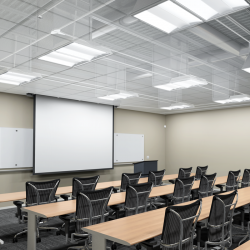“Lighting designers should aim to achieve Spatial Daylight Autonomy values of 75 percent or higher in classroom.”
Eneref Institute examines the importance of the new WELL building standard for daylight in classroom design.
Today we know that optimizing daylight as a light source in school buildings improves students’ academic performance. Daylight drives natural circadian rhythms of hormones, organs, tissues and the sleep-wake cycle. School planners have an opportunity to design lighting that supports alertness, mood and cognitive functions. The new WELL Building Standard for daylighting is designed to reinforce a normal circadian rhythm and improve visual acuity. To enhance student performance, architects should provide illuminance recommendations that maximize natural daylight.
Careful architectural planning and utilization of daylight to illuminate rooms, in conjunction with lighting controls to dim tunable-white LED electrical light sources, is not only efficient for buildings but also healthy for occupants, both students and faculty alike.
Many recent research discoveries should compel schools to specify natural interior daylight as a primary light source in classrooms, as advised by the WELL Building Standard. In 2012, the American Medical Association adopted a policy statement citing evidence that links circadian rhythm disruption to impacts on human health. In fact, the 2017 Nobel Prize in Medicine was awarded to three scientists for their discoveries of the molecular mechanisms underlying circadian rhythm.

Synchronizing our circadian rhythm requires periods of brightness and darkness.
